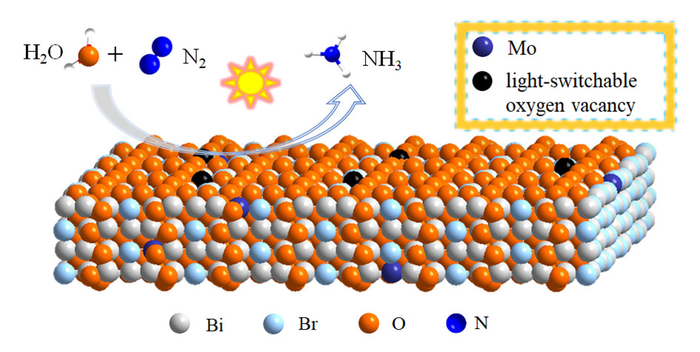Reviewed by Alex SmithSep 6 2021
The efficient reduction of nitrogen (N2) to ammonia (NH3) has been a major challenge for decades as it is difficult to break the inert N≡N bond due to its extremely large bond energy of 940.95 kJ mol–1.
 Researchers have presented a strategy by simultaneously introducing light-switchable oxygen vacancy and doping Mo into Bi5O7Br nanosheets for efficient photocatalytic N2 fixation. The modified photocatalyst has achieved elevated N2 fixation photoactivities by virtue of the optimized conduction band position, enhanced light availability, improved N2 adsorption, and charge carrier separation. Image Credit: Chinese Journal of Catalysis.
Researchers have presented a strategy by simultaneously introducing light-switchable oxygen vacancy and doping Mo into Bi5O7Br nanosheets for efficient photocatalytic N2 fixation. The modified photocatalyst has achieved elevated N2 fixation photoactivities by virtue of the optimized conduction band position, enhanced light availability, improved N2 adsorption, and charge carrier separation. Image Credit: Chinese Journal of Catalysis.
Until now, the energy-intensive Haber-Bosch process (involving 673 K–873 K and 15 MPa–25 MPa) largely dominates the industrial fixation of N2 to NH3. This process unsustainably uses natural gas to make the hydrogen (H2) feedstock with huge energy consumption from fossil fuels.
This results in the large-scale emission of carbon dioxide (CO2). Thus, photocatalytic N2 reduction is considered a sustainable alternative for producing NH3 from N2 and water under ambient conditions.
Yet, most of the conventional photocatalysis' arenot up to the efficient level primarily due to the hard bond dissociation of the inert N2. This is caused by the weak binding of N2 to the catalytic material and also inefficient electron transfer from photocatalyst into the antibonding orbitals of N2.
Setting up electron donation centers as the catalytic activation sites for optimizing N2 adsorption characteristics and enhancing the photoexcited charge transport in the catalysts is a potential approach for improving the efficiency of N2 photo-fixation.
Oxygen vacancy (OV) constitutes the most commonly and prevalently investigated kind of surface defect for N2 fixation. OV can be easily produced for its relatively low formation energy. Moreover, OV is capable of supporting photocatalysts to yield exciting N2 fixation photoactivity due to its dominating aspect in N2 capture and activation.
A semiconductor with sufficient OVs would thus help enhance its N2 fixation performance. Transition metal (TM) doping is another majorly studied effective method to enhance the photoactivity of N2 fixation.
This is because the TM species features the beneficial ability of binding (and even functionalization) with inert N2 at low temperatures owing to their empty and occupied d-orbitals. This can acheive the TM-N2 interaction through the “acceptance-donation” of electrons.
Mo is a crucial element of the catalytic center in unknown Mo-dependent nitrogenase and has gained widespread attention for the N2 fixation. For this purpose, OVs-rich and Mo-doped materials would be perfect for N2 photo-fixation. Moreover, layered bismuth oxybromide (BiOBr) materials have gained wider attention because of their ideal band gaps and distinctive layer structures.
BiOBr-based semiconductors, such as Bi3O4Br and Bi5O7Br, have shown that OV with adequate localized electrons on their surface enables the captivation and activation of inert N2 molecules.
A team of researchers headed by Prof. Yi-Jun Xu from Fuzhou University, China, found that when OVs and Mo dopant are introduced into Bi5O7Br nanosheets, the photoactivity of N2 fixation is significantly enhanced. The altered photocatalysts have exhibited enhanced N2 adsorption, the ideal conduction band position, improved light absorption and charge carrier separation, which together add to increasing N2 fixation photo-activities.
This study offers a potential way to develop photocatalysts with light-switchable OVs for N2 reduction to NH3 under mild conditions, projecting the broad application scope of nanostructured BiOBr-based photocatalysts as effective N2 fixation systems.
Journal Reference:
Chen, X., et al. (2021) Enhanced ambient ammonia photosynthesis by Mo-doped Bi5O7Br nanosheets with light-switchable oxygen vacancies. Chinese Journal of Catalysis. doi.org/10.1016/S1872-2067(21)63837-8.